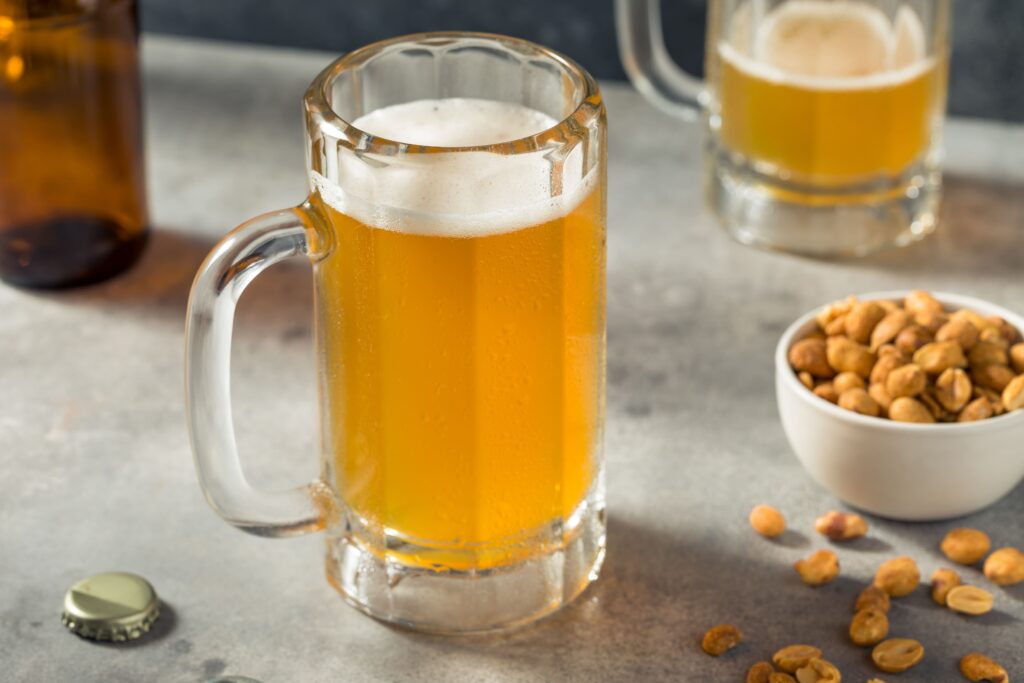Pilsner – the original pale lager and perhaps, the greatest among all beers! You may think we are exaggerating with the last bit, but given the popularity of Pilsners worldwide, it is safe to say that many share the sentiment.
When you think of a lager, chances are that you are imagining a tall glass of golden Pilsner beer. A welcome deviation from its dark and cloudy precursors, Pilsners were indeed the first pale lager to be brewed. Light and clear, this exhilarating beer has been capturing hearts across the globe since its origin.
So, What’s their story? Why are they so popular? What sets them apart from other beers? We hope to answer these questions with this comprehensive guide to Pilsners. Once you get familiar with this crisp and refreshing lager, check out our beer collection at Little Miami Brewing Company – the best place to get acquainted with all kinds of craft beers!
The Origins of Pilsner
The name ‘Pilsner’ is often interchanged with ‘lager’ since it is the most popular pale lager in the world. To clear the confusion, experts point out that ‘All Pilsners are lagers, but not all lagers are Pilsners’. Lagers are a type of beer, produced using bottom-fermenting yeasts in colder temperatures, as opposed to ales which use top-fermenting yeasts in warmer temperatures. Lager beers, stored in a cool dry place and aged for several weeks, became immensely popular among the public soon after their emergence. Lagers can be pale, amber and dark. Pilsner, the first pale lager, was an instant hit and is still one of the most enjoyed beverages globally.
Pilsner originated in the small town of Pilsen (Plzeň) in Bohemia, currently part of the Czech Republic, in the 19th century. It has an interesting backstory that starts with a revolt. The people of Pilsen, fed up with their terrible beer, poured vats of the beverage down the street. This led to the creation of a city-owned brewery, named Pilsner Urquell, born out of the collaboration of local architect Martin Stelzer and Bavarian brewmaster Josef Groll. The modern Pilsner was brewed here in 1842. This pale beer with its longer shelf life was a welcome change to the Bohemians, who were disappointed with the quality of their dark ales.
This golden light-bodied liquid with its distinctive hop aroma, thus, revolutionized the world of beer. Due to a delay in patenting, Pilsner amassed many imitations with its rising popularity. However, 182 years later, Pilsner Urquell continues to brew premium quality pilsners. As for the question of how it gained international fame, it was the German immigrants who brought Pilsner to the Americas. Now that does not come as a surprise, does it, given Germany’s love for good beer?
Pilsner: What Sets It Apart From Other Beers?
With subtle barley and hop flavors, this light-bodied lager is easy to drink. Pilsners are made with pale malt and lager yeast, through a production process called lagering. This process involves the fermentation of the wort (the liquid extract of malted grains) in colder temperatures, aided by the presence of bottom-fermenting yeast. With a crisp and clean finish, Pilsner usually has moderate alcohol content, with an ABV of 4%-5%.
As is the case of pale lagers, the color of Pilsner beers ranges from light to golden yellow. This beer has the tantalizing aroma of hops and malt that all beer enthusiasts love. The balanced flavors of malt and hops give this drink sweet, bitter and spicy notes, which can also include earthy, floral and herbal ones. The pronounced bitterness is often the influence of the Saaz hops used in Pilsner production, particularly of the Bohemian style. The superior taste of Pilsner Urquell is attributed to the soft water of its city, free from any harsh minerals that might affect the quality of the beer.
To sum it up, pale malt, Bohemian Saaz hops and the soft water of Pilsen form the blueprint for a Pilsner Urquell. The imitations of this premium lager follow a similar formula with a few creative changes in the ingredients, depending on the place of brewing.
Exploring Different Types of Pilsner Beers

The different styles of Pilsner beers depend on the location where they are brewed. This can result in subtle differences in ingredients, flavor and tasting notes. Generally, three main types of Pilsners are recognized – Czech, German and American. Let’s take a look at them:
Czech/Bohemian Pilsner
The original Pilsner, with its deep golden color, offers a nice and clean finish. Brewed in the Czech Republic, this Pilsner has notes of toasted malt and spicy hops and is noted for its distinct bitterness. Sweeter than its German counterpart, Bohemian Pilsners typically use light malt and Saaz hops. The soft Pilsen water gives it great clarity and a soft texture. The brewing process of Czech Pilsners has not changed much since its discovery in 1842.
German Pilsner
From a pale yellow to light gold, the German Pilsner, also known as Pils, has sweet and citrusy flavors. With medium to high bitterness levels that tend to linger on the palate, they are more hop-forward than the Czech Pilsner. In the case of German Pilsner, Saaz hop is at times replaced with any other German noble hop. Despite being the younger Pilsner, this style is more popular than the Bohemian one. It has a creamy and long-lasting white head. They have unfiltered versions as well, which can give the drink a hazy appearance.
American Pilsner
Brought by German immigrants, Pilsner quickly became a favorite among the beer lovers of the U.S., but not without the brewers adding a twist of their own to make it more suited to the American palate. This was done by adding corn and North American hops while brewing the beer. With an increased level of spice and bitterness, this Pilsner is much more flavor-intense than the other two styles. The alcohol content is high as well, with an ABV surpassing 5% in many cases. American Pilsners were a huge part of the craft beer movement in the U.S. and they continue to enjoy their position among the list of beloved beers.
Aside from these much-admired categories, European-style Pilsners, which include Belgium and Dutch Pilsners, are also very popular.
Your Favorite Companion for All Occasions
When should you choose a Pilsner for a drink? The answer is … anytime! (Come on over Little Miami Brewing to have a taste!).
Known for its versatility, Pilsners can be enjoyed on a wide variety of occasions. From casual gatherings to wedding parties and drinking nights, a chilled Pilsner is your best buddy. Its simple yet stimulating flavor lets you pair it with an array of foods, from tangy and spicy to light and sweet. While it’s one of the hardest beers to brew, Pilsners are easy to drink – perhaps why it is enjoyed by a great number of people. Served cold, these beers are simply marvelous on a hot sunny day. While its appeal is at its peak during the summer months, it can also be enjoyed all year round.
Magic Food Pairings to Elevate Your Pilsner Experience
As we have already mentioned, one of the best perks of Pilsner is its simple yet versatile nature that allows a variety of food pairings from light appetizers to spicy delights. A general rule of thumb is to match the intensity of the beer with that of the food. This is to prevent one from overpowering the other. You can also be creative and choose contrasting pairs as well.
Roasted meat and chicken are well-suited for these beers, as are fried and salty snacks. German Pilsners are an amazing combination with the mouthwatering spicy flavors of Indian and Mexican cuisines. Milder dishes from Indian and Thai cuisines pair well with Bohemian Pilsners, along with Chinese and Japanese dishes. Seafood including grilled fish and shellfish, many types of cheeses, salads and even fruits and veggies are fair game when it comes to Pilsners. If you have a sweet tooth, try Pilsners with shortbread cookies or strawberries and cream.
We offer numerous pizza options, including a customizable one, that pairs perfectly with our amazing beer here at Little Miami Brewing Company. ‘The Holy Smoke Pulled Pork’ pizza, for instance, has a BBQ sauce base, pulled pork, bacon, cheddar cheese, red onions and drizzled mustard bbq sauce, with pickles on the side – an explosion of spicy and tangy flavors, when paired with a Pilsner, is nothing short of heaven. Our salads, sandwiches and sweets are some beloved options that you can go with, if you are looking for something lighter with that tall glass of Pilsner.
Want more options? Take a look at our menu of delectable dishes at Little Miami Brewing Company. You can always rely on us to provide top-quality beer and its best food pairings. That said, you are always welcome to experiment with unique food combos as well. Don’t be afraid to break the rules of beer-food combos – you may strike gold, after all!
The Best Way to Serve Pilsner
Serving temperature, manner of pouring and even the choice of glassware have an impact on the beer of your choice. These practices can also vary according to location. For instance, in the Czech Republic, the birthplace of Pilsner, the traditional method is slow pouring, which results in a large head of foam. Usually, beers are often poured at an angle of 45°. Halfway through pouring, the glass is gradually straightened, which helps form a generous head.
Like all lagers, Pilsners are best served cold, ideally around 38°-45° F. Did you know that there are different ways to pour a beer? This is because the manner of serving can affect the foam and heighten the enjoyment of the beer. Some beers, like Pilsner, often take about 5 minutes to be poured, to make the best out of it. This technique enhances the delicate flavors and aromas of the Pilsner beer. It is definitely worth the wait!
It goes without saying that much like most beers, Pilsners have their own prescribed glasses. The design of the glass helps maintain the carbonation and highlight the flavors and aromas of the beer. Tall and slim, these glasses are perfect for showing off the iconic color and foamy head of a Pilsner. They have a narrow base and wide mouth, which allows the beer bubbles to rise to the top. It is a treat to the eyes and the palate!
Visit Us at Little Miami Brewing Company
Little Miami Brewing Company is known for award-winning craft beers and delicious food to go with it. We are a local craft brewery in Cincinnati with a mission ‘to make other people passionate about great beer as we are’. While we offer many seasonal and special editions of Pilsner beer at Little Miami, our current best-selling Pilsner is the Bohemian style Bike Path, brewed with British malt and spicy German noble hops.
We are a local brewery involved with the community. We also hold tasting events to bring people together for an evening of great beer and great fun! We have something for everyone – ales, lagers, wheat beer, fruit beer and even non-alcoholic options. Though we have a lot of fan-favorite drinks all year round, we also offer many specialty and seasonal brews. For more information, visit us on Facebook and Instagram, where you can find the list of upcoming weekly events and specialty beers. Don’t forget to follow us for regular updates!
Try a Sip of This Classic Lager This Weekend
Smooth, refreshing and easy to drink – it is no wonder that Pilsner is preferred by many. Even if you are a novice to drinking, you are bound to have heard of this classic drink. If you haven’t tried this golden beer already, don’t waste any more time! Visit us at Little Miami Brewing Company and experiment with all of our delicious beers! And don’t forget to look for our seasonal and specialty brews. Parties or weddings, beer tastings, or casual gatherings – we’ve got you covered!




